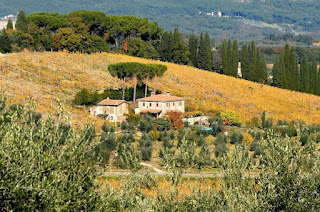Of all the misplaced expectations that visitors to Tuscany report, bread probably leads the pack. "
Why is Tuscan bread so bad?", they ask.
Well, if eaten the way the Tuscans eat it, Tuscan bread isn't bad, it's good. But it is unlike the crusty "Italian bread" sold in the States and, indeed, unlike most of the other breads sold in the homelands of our visitors.
 |
| Tuscan bread |
Tuscan bread is saltless and contains no keepers to maintain freshness. This means that it bakes with a light-coloured and sometimes soft crust, is fine grained and turns into concrete by lunchtime. It is therefore not what you want if your breakfast or lunch is bread or toast, with butter and jam. Hotels often provide Tuscan bread at breakfast time because guests have asked for bread over the years, but the results are usually bad because the hotels have no
idea of what a toast and jam breakfast is, and the guests completely
misconceive the place of Tuscan bread on the table. So when you're here in Tuscany, you should either enjoy an
Italian breakfast, meaning a sweet pastry and a coffee at a local bar, or buy the appropriate bread from a supermarket ("foreign" breakfast breads are, in fact, available in Supermarkets but rarely at bakeries).
For lunch, sandwich bread substitutes are readily available and extremely popular in Tuscany, forming, as they do, the basis for
panini, the popular Italian take away sandwich lunch. Various forms of
schiacciatina are often used to create a
panino, essentially a sandwich with the major difference that butter is almost always replaced with olive oil. Many Tuscan households don't use butter from one week to the next.
So how should Tuscan bread be eaten? In essence, Tuscan bread accompanies all phases of an Italian meal except the
dolce (dessert). That's why there's always a huge basket of bread in the middle of the table and also why it should always arrive at your table early on during a restaurant meal. Slices of bread, moistened by spreads of olive oil, chopped tomatoes and so on, might also be served up as an
antipasto in the form of
crostini,
bruschetta or
fettunta. Tuscan bread goes perfectly with salty
antipasti such as
salami and
prosciutto, but remember to pour a bit of olive oil onto your bread to soften it up and add flavour just before eating it. During the pasta and main courses, you use your bread to finish off any sauce left on the plate.
In the country, the evening meal might consist mostly of dishes based primarily on bread. Indeed, when the rural regions of Italy were much poorer than they are now, bread and oil were the staff of life, and dishes like
ribollita and
panzanella were eaten every day.
Ribollita - the word means 're-boiled' - is a winter 'soup' that consists mostly of the day's remaining bread added to a pot of white beans, vegetables and, most important of all, a kale called
cavolo nero. Generations of Tuscans have survived the winter eating
ribollita.
Panzanella is a summer dish, basically a light bread salad that also uses up the bread left at the end of the day.
Conclusion? When in Tuscany, as far as bread is concerned, do as the Tuscans do and you'll discover that our bread is perfectly adapted to complement our delicious traditional dishes!
More about Tuscan culinary specialities.
Useful information on what it costs to eat out in Tuscany.
All about ordering coffee in Tuscany.
Author: Anna Maria Baldini






















